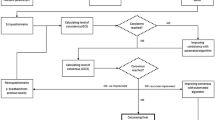Abstract
Objective
Current skills assessment in the Fundamentals of Laparoscopic Surgery (FLS) program is labor intensive, requiring one proctor for every 1–2 subjects. The ProMIS Augmented Reality (AR) simulator (Haptica, Dublin IR) allows for objective assessment of physical tasks through instrument tracking technology. We hypothesized that the ProMIS metrics could differentiate between ability groups as well as standard FLS scoring with fewer personnel requirements
Methods
We recruited 60 volunteer subjects. Subjects were stratified based on their laparoscopic surgical experience. Those who had performed more than 100 laparoscopic procedures were considered experienced (n = 8). Those with fewer than 10 laparoscopic procedures were considered novices (n = 44). The rest were intermediates (n = 8). All subjects performed up to five trials of the peg transfer task from FLS in the ProMIS simulator. The FLS score, instrument path length, and instrument smoothness assessment were generated for each trial.
Results
For each of the five trials, experienced surgeons outperformed intermediates, who in turn outperformed novices. Statistically significant differences were seen between the groups across all trials for FLS score (p < 0.001), ProMIS path length (p < 0.001), and ProMIS smoothness (p < 0.001). When the FLS score was compared to the path length and smoothness metrics, a strong relationship between the scores was apparent for novices (r = 0.78, r = 0.94, p < 0.001) respectively), intermediates (r = 0.5, p = 0.2, r = 0.98, p < 0.001), and experienced surgeons (r = 0.86, p = 0.006, r = 0.99, p < 0.001).
Conclusions
The construct that the standard scoring of the FLS peg transfer task can discriminate between experienced, intermediate, and novice surgeons is validated. The same construct is valid when the task is assessed using the metrics of the ProMIS. The high correlation between these scores establishes the concurrent validity of the ProMIS metrics. The use of AR for objective assessment of FLS tasks could reduce the personnel requirements of assessing these skills while maintaining the objectivity.




Similar content being viewed by others
References
Derossis AM, Antoniuk M, Fried GM (1999) Evaluation of laparoscopic skills: a 2-year follow up during residency training. Can J Surg 42:293–296
Fraser SA, Klassen DR, Feldman LS, Ghitulescu GA, Stanbridge D, Fried GM (2003) Evaluating laparoscopic skills: setting the pass/fail score for the MISTELS System. Surg Endosc 17:964–967
Fried GM, Feldman LS, Vassiliou MC, Fraser SA, Stanbridge D, Ghitulescu G, Andrew CG (2004). Proving the value of simulation in laparoscopic surgery. Ann Surg 240:518–528
Gallagher AG, Richie K, McClure N, McGuigan J (2001). Objective psychomotor skills assessment of experienced, junior, and novice laparoscopists with virtual reality. World J Surg 25:1478–1483
Gallagher A, Ritter E, Champion H, Higgins G, Fried M, Moses G, Smith CD, Satava RM (2005) Virtual reality for the operating room: proficiency based training as a paradigm shift in surgical skill training. Ann Surg 241:364–372
Grantcharov T, Kristianson V, Bendix J, Bardram L, Rosenberg J, Funch-Jensen P (2003) Randomized clinical trial of virtual reality simulation for laparoscopic skills training. Br J Surg 91:146–150
McClusky D, Gallagher A, Ritter E, Lederman A, Van Sickle K, Baghai M, Smith C (2004) Virtual reality training improves junior residents’ operating room performance: results of a prospective randomized, double-blinded study of the complete laparoscopic cholecystectomy. Paper presented at American College of Surgeons, Clinical Congress, New Orleans. J Am Coll Surg 199:73
Seymour NE, Gallagher AG, Roman SA, O’Brien MK, Bansal VK, Andersen DK, Satava RM (2002). Virtual reality training improves operating room performance: results of a randomized, double-blinded study. Ann Surg 236:458–464
Author information
Authors and Affiliations
Corresponding author
Rights and permissions
About this article
Cite this article
Ritter, E.M., Kindelan, T.W., Michael, C. et al. Concurrent validity of augmented reality metrics applied to the fundamentals of laparoscopic surgery (FLS). Surg Endosc 21, 1441–1445 (2007). https://doi.org/10.1007/s00464-007-9261-5
Received:
Revised:
Accepted:
Published:
Issue Date:
DOI: https://doi.org/10.1007/s00464-007-9261-5




